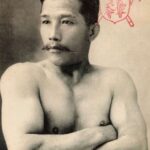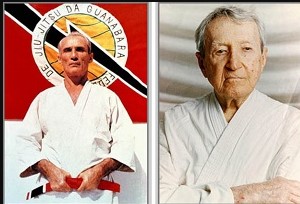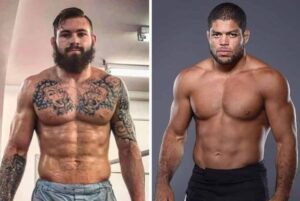
How has the Jiu-Jitsu physique changed throughout the years? While some might quote technological advances in training methodology as the culprit, it is actually steroids that have contributed the most to the physiques and performances we see on the Jiu-Jitsu mats today. From Mitsuyo Maeda and Masahiko Kimura to Gordon Ryan and Andre Galvao, the change is more than apparent.
The 1800s
During the 1800s, the physique of a professional grappler was far from what we are used to seeing today.
A great example is Yoshitsugu Yamashita, one of the four guardians of Kodokan Judo. He fought a lot, both on and off the mats, and while his physique is muscular, he is nowhere near the size or has the muscle definition of today’s professional grapples. That did not affect his performances, though.
Mitsuyo Maeda was active in the late 1800 and early 1900, and had a somewhat more defined Jiu-Jitsu physique compared to Yamashita. He was shorter but had broader shoulders and somewhat larger muscles. Still, with a shirt on he would not have looked muscular, but merely fit.
The 1900s Brazilian Jiu-Jitsu Physique
The Gracies took the Jiu-Jitsu physique in a different direction throughout the mid and late 1900s. They had no real muscle mass, but had lots of flexibility, range of motion and muscular endurance.
Seeing Carlos Gracie Sr. or Helio Gracie, nobody would associate them with strong people. They looked skinny at best. Their performances, however, tell a different story. The brothers used to swim, row, and do gymnastics and they sparred a lot, which they contribute to be the deciding factor in their ability to fight for hours.
For example, Helio fought Waldemar Santana in a no-time-limit match when he was 42. Santana was 26 years old at the time. The legendary match went on for 3.5 hours and would’ve gone on longer if not for a soccer kick following a slam that brought the victory to the 60 lbs heavier Santana.
The 2000s Modern Jiu-JItsu Physique
Toward the end of the 1900s and the start of the 2000s, the Jiu-Jitsu physique started to change notably. This had to do with training methods, accelerated by the growth of MMA, but also something else.
If you take a look at Gordon Ryan, Andre Galvao, Rousimar Palhares, Kaynan Duarte, you’ll see they all resemble superheroes at the very least. One could go further and compare them to the Incredible Hulk in terms of their Jiu-JItsu physique.
While it is clear that the effectiveness of Jiu-Jitsu is not subject to muscle mass and strength, the Jiu-Jitsu physique standard of today, especially for heavier grapplers, seems to be similar to that of a bodybuilder.
As Lachlan Giles proved in the 2019 ADCC, small guys can still beat these giants with technique, tactics, and endurance, raising the question of whether or not this type of physique actually helps grapplers?
Endurance Is Key
Most people will agree that it is the hours spent in training that matter the most. This builds grappling-specific endurance that helps grapplers fight for long periods of time, in long matches or repetitive shorter ones.
The fact of the matter is, though, that endurance is big, and often not talked about the effect of steroids. Just take a look at the physique of Lane Armstrong or Royce Gracie, both of whom look like they’ve never lifted a day in their life, and yet were popped for steroid use. Even Paulo Miyao lost a world title due to the use of steroids and we all know how diminutive he is.
The change of the Jiu-Jitsu physique throughout the years has been massively affected by unregulated steroid use, but it is not the muscle mass that makes the playing field uneven. It is the endurance that comes from the PEDs which really makes a difference. This is what gives long-lasting power to all those muscles, tipping the scales in the favor of modern Hulk-like figures.
Of course, we’ll see a Lachaln Giles-like giant-slaying story from time to time, but those are rare, and becoming even rarer.


![Darce Choke Encyclopedia – Origins, Mechanics and Variations [2025] BJJ, choke, Brabo, BJJ Darce Choke, D'arce Choke, Darce BJJ Choke](https://bjj-world.com/wp-content/uploads/2017/11/JungPoirierLeeYahoo-218x150.jpg)














![Countering with Crab Ride Anthony Budion DVD Review [2025] Countering with Crab Ride Anthony Budion DVD Review](https://bjj-world.com/wp-content/uploads/2025/03/countering-with-crab-ride-anthony-budion-dvd-review-218x150.png)
![Closet Closed Guard Craig Jones DVD Review [2025] Closet Closed Guard Craig Jones DVD Review](https://bjj-world.com/wp-content/uploads/2025/03/closet-closed-guard-craig-jones-dvd-review-218x150.png)
![Xanadu Back Takes Levi Jones-Leary DVD Review [2025] Xanadu Back Takes Levi Jones-Leary DVD Review](https://bjj-world.com/wp-content/uploads/2025/03/xanadu-back-takes-levi-jones-leary-dvd-review-218x150.png)

![No-Gi Grapplers Guide To Front Headlock Joel Bane DVD Review [2025] No-Gi Grapplers Guide To Front Headlock Joel Bane DVD Review](https://bjj-world.com/wp-content/uploads/2025/03/no-gi-front-headlock-joel-bane-dvd-review-218x150.png)

![Slay The Wrestle Up Guard Nick Rodriguez DVD Review [2024] Slay The Wrestle Up Guard Nick Rodriguez DVD Review](https://bjj-world.com/wp-content/uploads/2024/12/slay-the-wrestle-up-guard-nick-rodriguez-dvd-review-324x235.png)
![Zen Guide To Submission Grappling Margot Ciccarelli DVD Review [2025] Zen Guide To Submission Grappling Margot Ciccarelli DVD Review](https://bjj-world.com/wp-content/uploads/2025/02/submission-grappling-margot-ciccarelli-dvd-preview-100x70.png)

![No-Gi Defense Xande Ribeiro DVD Review [2024] No-Gi Defense Xande Ribeiro DVD Review](https://bjj-world.com/wp-content/uploads/2024/11/no-gi-defense-xande-ribeiro-dvd-review-100x70.png)

![Countering with Crab Ride Anthony Budion DVD Review [2025] Countering with Crab Ride Anthony Budion DVD Review](https://bjj-world.com/wp-content/uploads/2025/03/countering-with-crab-ride-anthony-budion-dvd-review-100x70.png)



![Osoto Gari for Jiu Jitsu Jackson Nagai DVD Review [2024] Osoto Gari for Jiu Jitsu Jackson Nagai DVD Review](https://bjj-world.com/wp-content/uploads/2024/10/osoto-gari-for-jiu-jitsu-jackson-nagai-dvd-review-100x70.png)

![Don’t Stand Up Chris Wojcik DVD Review [2024] Don't Stand Up Chris Wojcik DVD Review](https://bjj-world.com/wp-content/uploads/2024/11/dont-stand-up-chris-wojcik-dvd-review-100x70.png)
![Slip N Slide Into Victory Julián Espinosa DVD Review [2025] Slip N Slide Into Victory Julián Espinosa DVD Review](https://bjj-world.com/wp-content/uploads/2025/01/slip-n-slide-into-victory-julian-espinosa-dvd-review-100x70.png)
![Jeff Glover Deep Half Revolution DVD Bundle Review [2024] Jeff Glover Deep Half Revolution DVD Bundle Review](https://bjj-world.com/wp-content/uploads/2024/10/jeff-glover-deep-half-revolution-dvd-bundle-review-100x70.png)









![Baby Shark Guard System Diogo Reis DVD Review [2025] Baby Shark Guard System Diogo Reis DVD Review](https://bjj-world.com/wp-content/uploads/2025/02/baby-shark-guard-system-diogo-reis-dvd-review-100x70.png)


![Jeff Higgs Self Defense Guard BJJ DVD Review [2024] Jeff Higgs Self Defense Guard BJJ DVD Review](https://bjj-world.com/wp-content/uploads/2024/09/jeff-higgs-self-defense-guard-bjj-dvd-review-100x70.png)
![Bricks Kesa Gatame System Jeremy Brick DVD Review [2025] Bricks Kesa Gatame System Jeremy Brick DVD Review](https://bjj-world.com/wp-content/uploads/2025/02/bricks-kesa-gatame-system-jeremy-brick-dvd-review-100x70.png)